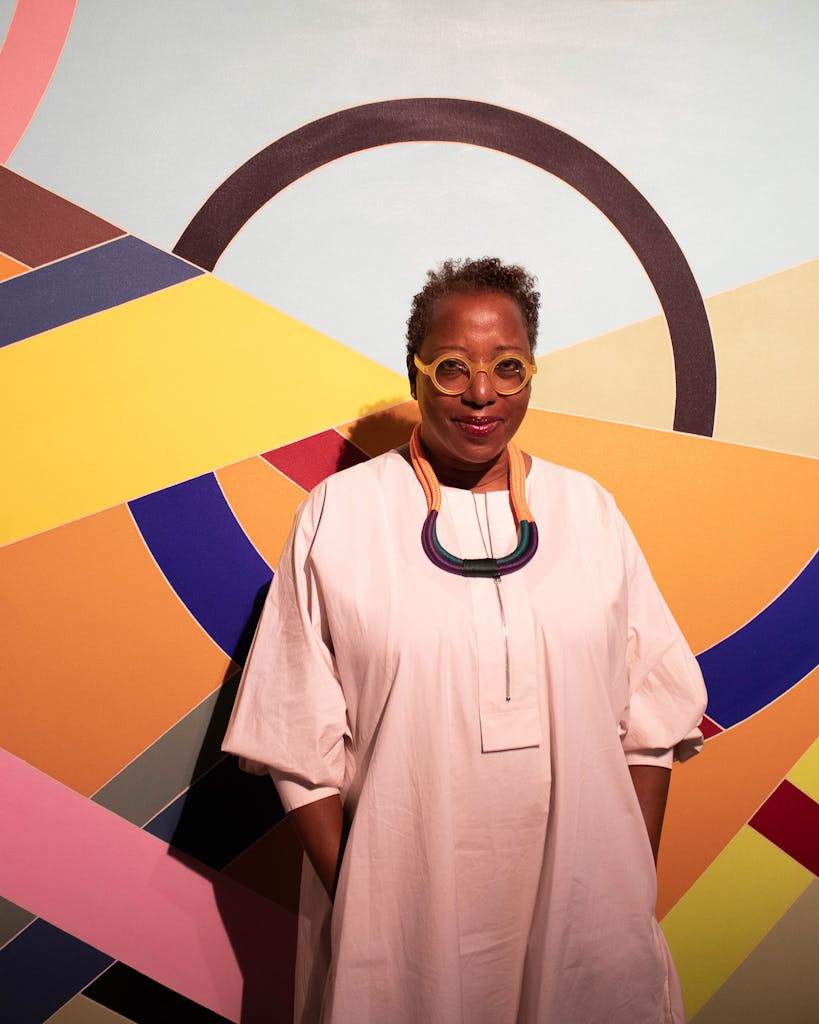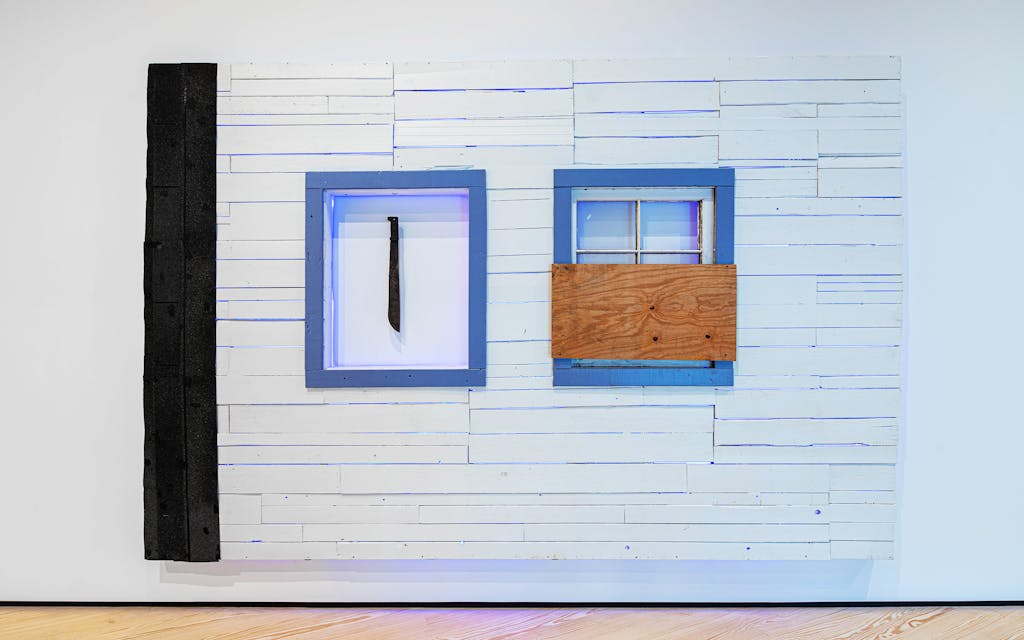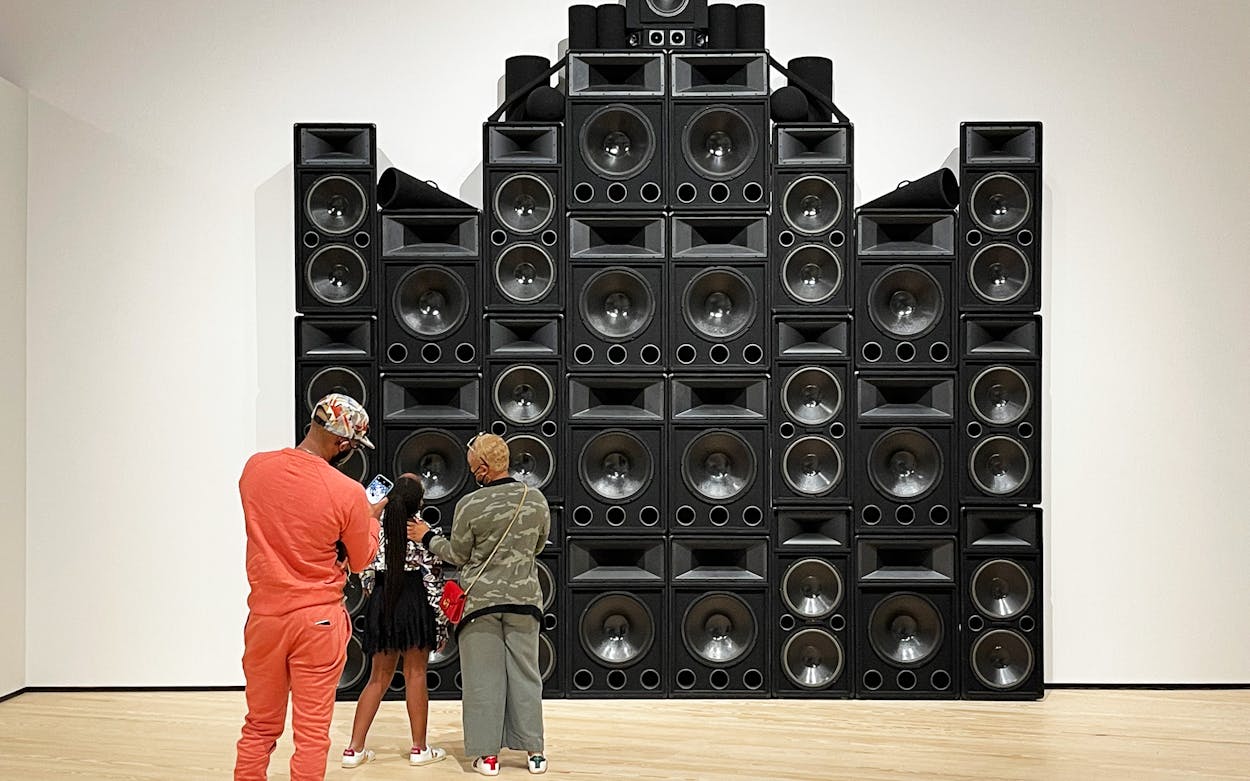Curator Valerie Cassel Oliver prefers free jazz. But in 2000, when she was hired by the Contemporary Arts Museum Houston, the beats of the Geto Boys and DJ Screw were pulsating through the city’s streets. Oliver didn’t just hear the gravitational force of Southern hip-hop. She also saw its zeitgeist filtering into the work of a new generation of visual artists, who were then emerging from Texas Southern University and Project Row Houses, the renowned Third Ward cultural and community enrichment site.
The music gave Oliver and other Black Texans “a new narrative of being Southern, and a new pride, quite frankly,” she says. “You’re dealing with land: the natural landscape, the man-made landscape, the shotgun houses, the clapboard churches. You’re also dealing with whole neighborhoods and how they shape and mold a certain viewpoint or perspective.” The work of these young artists—including Robert Pruitt, Jamal Cyrus, and other members of the collective Otabenga Jones & Associates—felt both revelatory and celebratory. “They were embracing spirituality. They were also embracing what it meant to be in a Black body in the South, and what had that wrought historically, and allowing the definition to extend beyond trauma . . . as a repository for traditions and a generator of joy and creative expression.”
Oliver was still mulling a show sprung from those synergies when the Virginia Museum of Fine Arts hired her away in 2017. As she combed through the VMFA’s vaults of paintings and sculptures, she found the trajectory she needed: evidence of a call and response between visual art and Southern music genres—namely gospel, the blues, and jazz—that’s been flowing for at least a century.
“The Dirty South: Contemporary Art, Material Culture, and the Sonic Impulse” debuted earlier this year at the VMFA in Richmond, to stellar national reviews. It’s now drawing a steady stream of visitors to the CAMH, where it’s on view through February 6.
Through paintings, sculpture, photography, film, sonic works, and installations by a prime list of artists past and present, the exhibition amplifies (and adds to) an oft-repeated statement by André 3000, half of Atlanta’s OutKast duo: not only has the South got something to say, it’s been saying something a long time. “That was the premise of the exhibition—really wanting to look at [Black Southern identity] not just in the contemporary but to understand that it has deep roots,” Oliver says.

The phrase “the dirty South” refers to many things: “a place, a feeling, an essence, a culture, a clear and present voice that had existed for centuries,” as a narrator explains in a promotional video for the show. All of that comes together with more than 120 works dating from the early twentieth century to the present, in a display that gives equal respect to highly trained academic artists and self-taught visionaries. Twelve of the show’s 92 artists are from Texas.
The main floor of the triangular CAMH building has been divided into galleries painted in rich colors that help guide visitors through the first two of the show’s three themed sections. Earthy clay walls denote the “Landscape” galleries, while white and haint blue (a color that carries historical meaning in Black Southern communities) walls identify works under the rubric of “Religion.” The final section, “The Black Body,” fills the lower floor, even displacing the gift shop.
You know an exhibition has clout when it consumes every square inch of a museum. And yet “The Dirty South” never overwhelms, drawing visitors into a thoughtful journey of sight and sound that conjures a palpable sense of continuum. The thematic sections may help viewers navigate ideas, but really, a number of these works could appear just about anywhere in the show.
Spirits seem to inhabit the entrance wall, setting a poetic and haunting tone. A large wall-dependent sculpture by Houston artist Nathaniel Donnett, titled I looked over Jordan and what did I see; a band of angels coming after me, looks like a fragment of an abandoned shack, with an eerie blue glow emanating through its wood siding and partially boarded windows. A signature Nick Cave Soundsuit from 2010, made of twigs, stands beside it. (With that juxtaposition, Oliver nods quickly to the show’s local origins and the importance of Texas talent.)

Historically significant works by John Biggers, the legendary artist who founded TSU’s art department, and Earlie Hudnall Jr., a Biggers protégé renowned for his photographs of Houston’s Black communities, lie just around the corner, where “Landscape” begins. Already, a visitor’s ears are alert to the show’s ambient sounds: the gurgle of water collides with snippets of a coronation anthem by George Frideric Handel, the raspy voice and steady tambourine of Sister Gertrude Morgan, and—most persistent of all—a deep beat thumping from a source that won’t reveal itself for a while.
The watery sounds emanate from Allison Janae Hamilton’s dreamy video Wacissa, which plunges viewers into an inverted landscape of North Florida rivers that were partially dug by enslaved people in the 1850s. That audio merges, too, with the moving images of Nomadic, a silent, meditative digital projection by Demetrius Oliver with constellations of buttons that appear and fade—like stars or bodies moving through the night—across the black suit of a headless figure. Throughout “The Dirty South,” beauty, terror, and resilience seem always to coexist, springing from the same place.
A viewer’s gaze drifts naturally from Oliver’s piece to Michi Meko’s simpatico black and gold painting The Seasons – Summer, which suggests a sea of shimmering fireflies above a blackened landscape. Similarly, a snakelike stick connecting the vessel and turntable at opposite ends of Kevin Sipp’s sculptural installation Take It to the Bridge/Trance-Atlantic draws eyes toward the big cotton bale and ominous-looking vintage hanging scales of Kaneem Smith’s evocative installation The Past Is Perpetual/Weighted Fleet.
Every piece invites lingering. In the “Religion” section,” Nadine Robinson’s evocative tribute to Martin Luther King Jr., Coronation Theme: Organon, dominates audibly and visibly. Made of thirty black speakers stacked to resemble a pipe organ as well as the facade of Atlanta’s Ebenezer Baptist Church, Robinson’s piece turns out to be the source of the Handel music, which is mixed with audio of sermons, songs, and protests. Those sounds linger as viewers absorb a number of terrifically mysterious works—some abstract and some that point distinctly toward the afterlife.
The devil seems to be winning in Rodney McMillian’s immersive Asterisks in Dockery (Blues for Smoke) installation, a chapel whose walls, floor, and ceiling are made of hand-sewn red vinyl. At first calling to mind a bouncy house for the hellfire and brimstone crowd, the space pays homage to Dockery Farms, a Mississippi plantation site that’s often referred to as the birthplace of the blues. Its temptations are impossible to resist, so plan to sit there a while and bask in it. Jason Moran (a pianist and composer who grew up in Houston) pays homage to the history of jazz with another room-scaled mixed-media installation, STAGED: Slugs’ Saloon. It seems a little odd that McMillian’s and Moran’s rooms don’t have audio components. But maybe it’s just as well, given the other ambient sounds that permeate the exhibit. Oliver seems to have figured out how much noise is just enough.
Downstairs, the gloves come off for “The Black Body” section, where a compelling mix of unflinching works made since the early 1950s brings visitors closer to the source and tension of that mysterious beat mentioned earlier. The young figures in Austinite Deborah Roberts’s lively 2018 painting Let Them Be Children are not smiling. Kerry James Marshall’s Untitled (Exquisite Corpse), a complex 2021 painting, is divided into horizontal sections, as if conceived while playing the Surrealist artists’ party game. Its dancing figure grows from a base of electrical cables, holding what could be a bag of money in one hand and a cross in the other. Next to it, the placement of Robert Hodge’s round mixed-media text piece Bert Williams (Tapdance) looks pretty genius.
In other works, words unseen create the magnetic force. Viewers must peer close to decipher the small, blind-embossed text of Bethany Collins’s In Mississippi, which reproduces poignant, post–Civil War newspaper ads placed by formerly enslaved people hoping to reunite with their separated families. Jamal Cyrus’s denim tapestry A Witness references the redacted FBI files of civil rights activist Fannie Lou Hamer. The hip-hop story comes home full circle in El Franco Lee’s dense painting DJ Screw in Heaven II, depicting mourners at the funeral of Houston’s chopped-and-screwed innovator, who died of an overdose in 2000.
One of the show’s most engrossing elements is unfortunately squeezed under the stairwell, where the gift shop normally resides. Make sure not to miss it. Wonder Cabinet is a wall-eating reliquary containing concert videos, ephemera, and sculptures that represent the long and linked history of music and art across the Southern U.S. Among the treasures: a Bo Diddley guitar, an Ornette Coleman sax, costumes worn by James Brown and CeeLo Green, a trove of Mose Tolliver ceramics, and other small sculptures, including Robert Pruitt’s shard-encrusted Glass Slippers and (tiniest of all) a diamond and gold grill by the Houston jeweler Johnny Dang.
If Wonder Cabinet is a glimpse into the exhibition’s brain, the dive into its soul comes in the dark screening room, where the source of that thumping beat finally reveals itself. It’s the sound of Arthur Jafa’s unsettling 2016 video montage Love Is the Message, the Message Is Death, set to Ye’s Ultralight Beam. An instant classic, Jafa’s masterpiece wraps up everything “The Dirty South” is about in seven hardcore minutes, leaving a viewer utterly spent. Its quick-cut footage—blending historical and original imagery—shockingly and elegantly depicts the violence and elation, tragedy, and transcendence of being Black in the South. It’s hard to watch, and necessary. Save it for last, watch it more than once, and walk out wiser.






